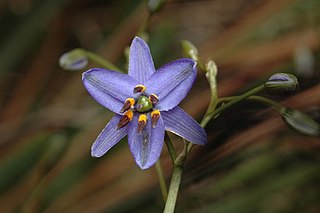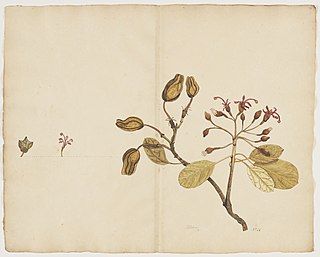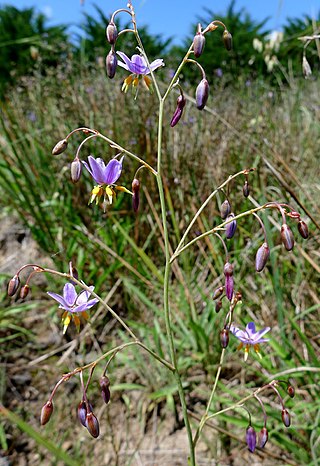
Araucaria is a genus of evergreen coniferous trees in the family Araucariaceae. While today they are largely confined to the Southern Hemisphere, during the Jurassic and Cretaceous they were distributed globally. There are 20 extant species in New Caledonia, Norfolk Island, eastern Australia, New Guinea, Argentina, Brazil and Chile.

Stephan Ladislaus Endlicher also known as Endlicher István László was an Austrian botanist, numismatist and Sinologist. He was a director of the Botanical Garden of Vienna.

Baloghia is a genus of plants under the family Euphorbiaceae first described as a genus in 1833. It is native to Australia, New Caledonia, and Vanuatu. Cocconerion is a close relative.

Alstroemeria psittacina, with the common names Peruvian lily, parrot flower, parrot lily, lily of the Incas, princess lily and New Zealand Christmas bell. It is found in cerrado and pantanal vegetation in Brazil and Argentina.

Dianella is a genus of about forty species of flowering plants in the monocot family Asphodelaceae, commonly known as flax lilies. Plants in this genus are tufted herbs with more or less linear leaves and bisexual flowers with three sepals more or less similar to three petals and a superior ovary, the fruit a berry. They occur in Africa, South-east Asia, the Pacific Islands, New Zealand and Australia.

Dianella tasmanica, commonly known as the Tasman flax-lily or Tasmanian flax-lily is a herbaceous strappy perennial herb of the family Asphodelaceae, subfamily Hemerocallidoideae, found in southeastern Australia including Tasmania. It has leaves to 80 cm, and a flower stem to 1.5 m. Blue flowers in spring and summer are followed by violet berries. It adapts readily to cultivation and is commonly seen in Australian gardens. Unlike other Dianella species, its fruit is toxic.

Dianella caerulea, commonly known as the blue flax-lily, blueberry lily, or paroo lily, is a perennial herb of the family Asphodelaceae, subfamily Hemerocallidoideae, found across the eastern states of Australia and Tasmania. It is a hardy plant, growing to a height and width of around 1 meter with grass-like strappy leaves. Blue flowers in spring and summer are followed by indigo-coloured berries. It adapts readily to cultivation and is commonly seen in Australian gardens and amenities plantings.

Amsinckia menziesii is a species of plant in the family Boraginaceae, the borage or forget-me-not family.

Dichelachne is a genus of Australian, Indonesian, and Pacific Island plants in the grass family. They are known commonly as plumegrasses.

Najas marina is a species of aquatic plant known by the common names spiny water nymph, spiny naiad and holly-leaved naiad. It is an extremely widespread species, reported across Europe, Asia, Africa, Australia, the Americas and many oceanic islands. It can be found in many types of freshwater and brackish aquatic habitat, including bodies of alkaline water.

Sarcomelicope simplicifolia, commonly known as bauerella, hard aspen or yellow-wood, is a species of flowering plant in the family Rutaceae and is endemic to eastern Australia including Lord Howe and Norfolk Islands. It is a shrub or small tree with elliptic to egg-shaped leaves arranged in opposite pairs, male or female flowers arranged in small groups in leaf axils and fruit an oval to spherical drupe.

Zehneria baueriana, commonly known as the native cucumber or giant cucumber, is a species of flowering plant – a vine in the cucumber and gourd family, Cucurbitaceae. It is found on Norfolk Island, an Australian territory in the Tasman Sea, as well as in New Caledonia. The specific epithet honours Austrian botanical illustrator Ferdinand Bauer who collected on Norfolk Island in 1804 and 1805.

Calystegia affinis is a critically endangered species of climbing or creeping vine in the plant family Convolvulaceae. It is endemic to Lord Howe Island and Norfolk Island. In 2003 only about 45 mature plants were known, with about 40 of those on Norfolk Island.
Dendrobium brachypus, commonly known as the dwarf cane orchid, is an epiphytic or lithophytic orchid in the family Orchidaceae. It has crowded, yellowish green pseudobulbs, dark green leaves and two or three cream-coloured to whitish or greenish flowers which often do not open fully. It grows on trees and rocks on one mountain on Norfolk Island.

Ungeria is a monotypic genus of flowering plants belonging to the family Malvaceae. It just contains one species, Ungeria floribundaSchott & Endl. It is also in the Helicteroideae subfamily and Helictereae tribe.

Myoporum obscurum, commonly known as popwood, sandalwood or bastard ironwood is a plant in the figwort family, Scrophulariaceae. It is a very rare shrub, endemic to Norfolk Island where it occurs in a few scattered locations.

Phreatia limenophylax, commonly known as the Norfolk Island caterpillar orchid is a plant in the orchid family, an epiphyte with four to six fleshy, channelled leaves in a fan-like arrangement. A large number of tiny white flowers are arranged along a thin flowering stem. It grows on the Solomon Islands, Norfolk Island and other islands of the southwest Pacific Ocean.

Dianella longifolia, commonly known as blueberry lily, pale flax lily or smooth flax lily, or blue flax-lily, is a species of flowering plant in the family Asphodelaceae and is endemic to non-arid areas of Australia. It is a tufted, rhizomatous, perennial herb with grass-like leaves, pale blue, white or greenish flowers that have pale yellow anthers, and shiny, pale blue berries.

Dianella amoena, commonly known as the matted flax-lily, is an endangered, herbaceous, perennial plant endemic to Australia. It belongs to the family Asphodelaceae, subfamily Hemerocallidoideae. It has long grey-green leaves which grow in clumps from an underground rhizome, and displays blue-purple flowers in spring-summer, up to 90cm in height. The common name Matted Flax-lily refers to its extensively rhizomatous nature, sometimes forming large mats up to 5m wide.

















